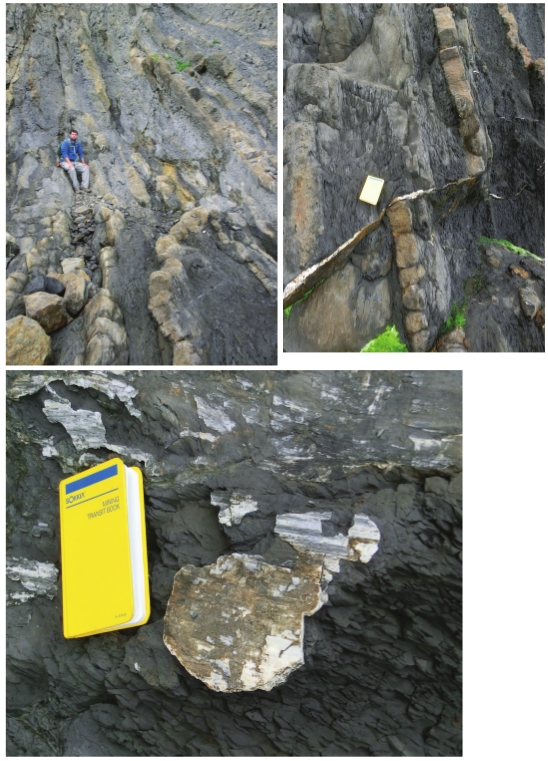|
We currently have 4
ongoing projects in Spain. The field localities are at A.) Ribera Alta,
B.) Orduna, and C.) Gernicka. Locations are shown in the northern part
of Spain on the Google Earth image below. Information pertaining
to the three field areas are provided in the following sections.
 |
-
One current project
entails measurement
of paleo-thermal halo dimensions around a structurally shallow diapir
in the western Pyrenees of northern Spain (Nick Downs, former M.S.
student advisee of Andrew Hanson). For this project, we sampled
Miocene strata within a single geologic unit along transects that
extend from near the diapir's margin out into adjacent areas that are
presumed to have not been effected by the high heat flux within the
diapir. The diapir is located in the Ribera Alta area, is oval in
shape, and approximately 2.5 km wide and 4.75 km long. We used
vitrinite reflectance to constrain the paleo-temperatures and our
initial results are shown in the following figure. Because this
diapir is structurally shallow, our hypothesis was that vitrinite
values would be elevated adjacent to the diapir compared to values
derived from samples that are more than 10 km away from the diapir.
The diapir is shown in pink on the geologic map which is overlain on
the Google Earth image of the area in the following figure. The
vitrinite data (red dots on the map) did not support our hypothesis,
instead we found suppressed vitrinite values near the eastern margin
of the diaper with higher values as you move away from the diaper;
vitrinite values on the western margin of the diapir are higher,
possibly related to the proximity to a significant structural front
further to the west or to ongoing fluid flow that is localized along
the western margin of the diapir. Based on current data, we interpret
a suppressed anomaly that is about 2x the diapirs diameter along its
eastern margin.
ONGOING WORK
We collected additional
mudstone
samples during our 2012 field season in order to better constrain
thermal variation along the eastern transect (shown as blue dots).
These analyses are in progress.
-
Our second focus area in
the Pyrenees
is around the diapir located at Orduna. Here the diapir is roughly
circular with an average diameter of about 3.5 km. Strata surrounding
the diapir are Coniacian in age, and this diapir represents a deeper
structural level than the one at Ribera Alta. Similar to our strategy
at Ribera Alta, we sampled around the diapir as well as along
transects within the same geologic unit as they extend many
kilometers away from the diapir. Our hypothesis pertaining to the
Orduna diapir was that values near the diapir will be suppressed
compared to those measured farther away from the diapir. This project
was part of Nick Downs' thesis project. The diapir is shown in pink
on the geologic map which is overlain on the Google Earth image of
the area in the following figure.
- Our third focus area in
the Pyrenees is
from an area east of Gernicka near the northern coast of Spain. At
this locality, we were able to sample Albian strata that crop out
both above and below a weld that resulted from evacuation of an
allochthonous salt body. Our hypothesis is that sub-salt samples will
have depressed vitrinite values and those from supra-salt will be
elevated. This project was also part of Nick Downs' thesis project.
Remnant salt is shown in pink on the geologic map which is overlain
on the Google Earth image of the area in the following figure.
Samples to the north of the weld are supra-salt, whereas those south
of the weld are sub-salt. The data show that the maturity values are
lower near the diapir root and that they become more elevated as you
move away from the diapir despite being taken from progressively
higher stratigraphic intervals. We interpret a slight change in
thermal maturity between the samples from existing transect data
based on whether they are sub-salt vs supra-salt (white circles on
following map) but the data are limited so we’ve collected
additional samples (red circles) from this area in order to more
fully characterize the thermal story.
 -
The Bakio diapir extends
from onshore
to offshore and is surrounded by deeper water latest Albian/early
Aptian to Cenozoic siliciclastic turbidites, some of which contain
carbonate breccia blocks. We observed cleavage, calcite filled veins
with slickenlines, and small faults near the margins of this diapir.
Our goal at Bakio is to document very near diapir thermal conditions.



|
